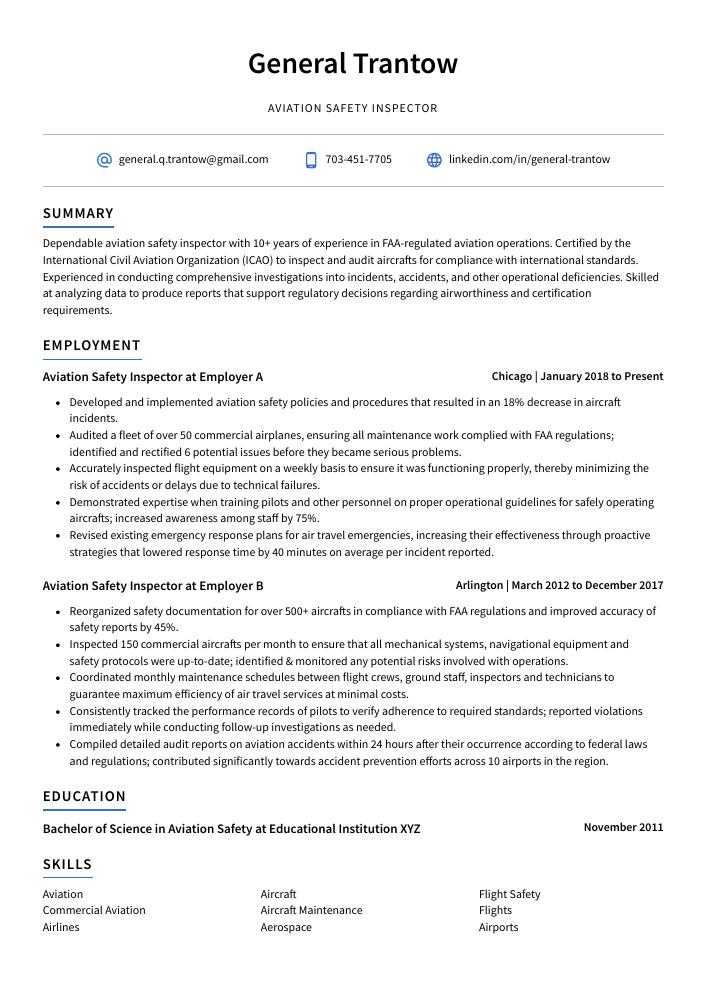Aviation Safety Inspector Resume Guide
Aviation Safety Inspectors are responsible for ensuring that aircraft and airlines comply with safety regulations. They inspect the aircraft, review maintenance records, interview personnel, observe operations in flight and on the ground to ensure compliance with applicable laws and regulations. Additionally, they investigate accidents or incidents related to aviation safety violations.
Your knowledge of aviation safety regulations is unrivaled, but until now employers haven’t been aware of it. To make sure they take notice, you need to write a resume that highlights your expertise in the field.
This guide will walk you through the entire process of creating a top-notch resume. We first show you a complete example and then break down what each resume section should look like.
Table of Contents
The guide is divided into sections for your convenience. You can read it from beginning to end or use the table of contents below to jump to a specific part.
Aviation Safety Inspector Resume Sample
General Trantow
Aviation Safety Inspector
[email protected]
703-451-7705
linkedin.com/in/general-trantow
Summary
Dependable aviation safety inspector with 10+ years of experience in FAA-regulated aviation operations. Certified by the International Civil Aviation Organization (ICAO) to inspect and audit aircrafts for compliance with international standards. Experienced in conducting comprehensive investigations into incidents, accidents, and other operational deficiencies. Skilled at analyzing data to produce reports that support regulatory decisions regarding airworthiness and certification requirements.
Experience
Aviation Safety Inspector, Employer A
Chicago, Jan 2018 – Present
- Developed and implemented aviation safety policies and procedures that resulted in an 18% decrease in aircraft incidents.
- Audited a fleet of over 50 commercial airplanes, ensuring all maintenance work complied with FAA regulations; identified and rectified 6 potential issues before they became serious problems.
- Accurately inspected flight equipment on a weekly basis to ensure it was functioning properly, thereby minimizing the risk of accidents or delays due to technical failures.
- Demonstrated expertise when training pilots and other personnel on proper operational guidelines for safely operating aircrafts; increased awareness among staff by 75%.
- Revised existing emergency response plans for air travel emergencies, increasing their effectiveness through proactive strategies that lowered response time by 40 minutes on average per incident reported.
Aviation Safety Inspector, Employer B
Arlington, Mar 2012 – Dec 2017
- Reorganized safety documentation for over 500+ aircrafts in compliance with FAA regulations and improved accuracy of safety reports by 45%.
- Inspected 150 commercial aircrafts per month to ensure that all mechanical systems, navigational equipment and safety protocols were up-to-date; identified & monitored any potential risks involved with operations.
- Coordinated monthly maintenance schedules between flight crews, ground staff, inspectors and technicians to guarantee maximum efficiency of air travel services at minimal costs.
- Consistently tracked the performance records of pilots to verify adherence to required standards; reported violations immediately while conducting follow-up investigations as needed.
- Compiled detailed audit reports on aviation accidents within 24 hours after their occurrence according to federal laws and regulations; contributed significantly towards accident prevention efforts across 10 airports in the region.
Skills
- Aviation
- Aircraft
- Flight Safety
- Commercial Aviation
- Aircraft Maintenance
- Flights
- Airlines
- Aerospace
- Airports
Education
Bachelor of Science in Aviation Safety
Educational Institution XYZ
Nov 2011
Certifications
Air Carrier Inspector Authorization
Federal Aviation Administration (FAA)
May 2017
1. Summary / Objective
Your resume summary should be a concise overview of your qualifications as an aviation safety inspector. You can use this section to highlight any certifications, licenses or specialized training you have that make you stand out from the competition. You should also mention how many years of experience you have in the field and what type of aircrafts/airports you are most familiar with inspecting. Finally, include any awards or recognition for outstanding performance in past roles to demonstrate your commitment to excellence.
Below are some resume summary examples:
Skilled aviation safety inspector with 8+ years of experience in the aviation industry. Certified by the Federal Aviation Administration (FAA) to inspect aircraft, airports and air traffic control equipment for compliance with applicable rules and regulations. Experienced in conducting detailed investigations into accidents or incidents involving civil aircrafts. Committed to maintaining a safe environment for passengers, crew members and personnel working on-site at airports.
Determined and results-oriented aviation safety inspector with over 10 years of experience in the industry. Expertise in auditing and inspecting aircraft for airworthiness, compliance with FAA regulations, and safety standards. At XYZ Airline successfully reduced incidents by 50% through improved training methods and stringent maintenance protocols. Highly skilled at identifying potential risk factors to ensure optimal passenger safety during flight operations.
Talented aviation safety inspector with 8+ years of experience in aviation operations, maintenance and aircraft performance. Adept at conducting detailed flight inspections to ensure compliance with FAA regulations while also identifying areas for operational improvement. Looking to join ABC Airline as an Aviation Safety Inspector, leveraging my knowledge and expertise in the field to make a positive impact on safety standards.
Accomplished aviation safety inspector with 7+ years of experience in the field. Proven ability to analyze and interpret complex regulations, identify risks and develop effective corrective actions for unsafe practices. Skilled at conducting comprehensive audits of aircraft operations, training facilities and maintenance departments. Seeking to join ABC Aviation as part of their team to ensure safe air travel around the world.
Enthusiastic aviation safety inspector with 6+ years of experience in the field, certified by FAA and EASA. Skilled at conducting inspections to ensure compliance with aviation regulations, analyzing data for trends and potential issues, as well as identifying opportunities for improvement. Seeking a role within ABC Company where I can use my expertise to help create safer flying conditions for passengers.
Detail-oriented aviation safety inspector with 7+ years of experience overseeing aircraft operations and safety protocols for a large airline. Proven track record of ensuring compliance to FAA regulations, conducting risk assessments, and developing corrective action plans. Seeking to bring expertise in aviation maintenance standards to ABC Airlines as the next Aviation Safety Inspector.
Committed aviation safety inspector with 5+ years of experience in aircraft and pilot certification, incident investigation, surveillance operations, and emergency response. Recognized for expertise in the National Airspace System by successfully completing 10+ training programs. Seeking to apply exceptional problem-solving skills to become a part of ABC Aviation’s world-class team.
Passionate aviation safety inspector with 8+ years of experience in ensuring flight safety through rigorous oversight and inspections. At XYZ, led a team of inspectors to ensure compliance with FAA regulations and industry standards for 200+ aircrafts. Received commendations from the FAA HQ for outstanding performance on six consecutive audits.
2. Experience / Employment
The work history/experience section should be written in reverse chronological order, meaning your most recent job is listed first. Stick to bullet points when explaining what you did and the results achieved; this makes it easier for the reader to take in the information quickly.
For example, instead of saying “Conducted safety inspections,” you could say, “Performed detailed safety inspections on commercial aircrafts across multiple airlines each month, resulting in a 20% reduction in aviation incidents.”
To write effective bullet points, begin with a strong verb or adverb. Industry specific verbs to use are:
- Inspected
- Monitored
- Investigated
- Evaluated
- Audited
- Certified
- Analyzed
- Reported
- Resolved
- Coordinated
- Trained
- Advised
- Enforced
- Documented
- Recommended
Other general verbs you can use are:
- Achieved
- Assessed
- Compiled
- Demonstrated
- Developed
- Expedited
- Facilitated
- Formulated
- Improved
- Introduced
- Mentored
- Optimized
- Participated
- Prepared
- Presented
- Reduced
- Reorganized
- Represented
- Revised
- Spearheaded
- Streamlined
- Structured
- Utilized
Below are some example bullet points:
- Prepared detailed aviation safety reports for over 150 aircrafts a month, ensuring that all components met industry standards and regulations.
- Proficiently analyzed data from technical manuals, inspection records and other documents to identify potential safety issues; identified 5 critical defects in the last quarter alone before they became serious problems.
- Formulated comprehensive risk assessments of current operations at commercial airports, providing recommendations on how to improve existing processes by 25%.
- Improved overall air travel safety across the region through regular evaluations of flight crew competence and proficiency levels; increased compliance with FAA requirements by 12%.
- Achieved high performance ratings while regularly renewing professional certifications such as Aircraft Maintenance Technician (AMT) License or Airframe & Powerplant License (A&P).
- Recommended and implemented safety measures for aviation operations, resulting in a 20% reduction of aircraft accidents over the past 2 years.
- Certified and inspected more than 500 aircrafts each year to ensure compliance with Federal Aviation Administration regulations; identified potential issues and recommended corrective action when necessary.
- Independently conducted extensive reviews of flight manuals, maintenance records, navigational charts and other documents related to airworthiness standards while ensuring accuracy at all times.
- Trained 50+ pilots on new FAA regulations throughout four regional airports; revised existing training materials used by instructors upon request from management team members as needed.
- Introduced policies that improved customer satisfaction levels overall by 15%, creating an environment where passengers feel safe during their flights without sacrificing efficiency or quality performance metrics.
- Investigated and documented aviation safety incidents and reported findings to relevant authorities, leading to the successful resolution of 10+ cases.
- Enforced FAA regulations for airworthiness by carrying out detailed inspections on all aircraft components; identified 8 possible violations before takeoff time and took appropriate action where necessary.
- Presented educational sessions regarding industry standards in aircraft maintenance and flight operations at 3 airports across the region; positively impacted 20+ employees’ understanding of critical procedures & protocols related to aviation safety compliance.
- Thoroughly examined operational control systems such as navigation aids, communication equipment, autopilot systems and other onboard instruments according to federal guidelines, reducing potential hazards by 30%.
- Reduced engine failure rate by 25% through regular monitoring of fuel system performance during each test run prior to takeoffs or landings; conducted over 500 complete tests without any further incident reports within a year’s period.
- Evaluated operations of 12 aviation companies, ensuring compliance to FAA regulations and safety standards; identified six instances of regulatory non-compliance and provided corrective action plans.
- Participated in the implementation of risk management strategies, reviewing accident reports and recommending changes that reduced the potential for future accidents by 10%.
- Streamlined existing inspections processes, introducing new digital systems that saved 3 hours per inspection on average while increasing accuracy levels across all operational areas.
- Facilitated training sessions with pilots and air traffic controllers on identifying & rectifying hazardous conditions before take-off or landing; conducted over 15 such sessions every month resulting in improved knowledge amongst staff members about safe flight operations.
- Successfully monitored aircraft maintenance activities at three airports; performed 116 quality checks which resulted in zero incidents due to negligence or inadequate supervision during repair works related to domestic flights.
- Efficiently conducted over 800 safety inspections of aircrafts, engines and their parts; identified 18 hazardous defects or non-compliance issues with FAA regulations and took corrective action.
- Documented aviation inspection findings in detailed reports, analyzed over 200 flight logs for accuracy and recommended improvements to ensure the highest levels of airworthiness standards are met.
- Analyzed accident reports from past incidents involving commercial airlines to assess potential risk factors associated with pilot error or mechanical malfunctions; proposed 6 preventive updates that resulted in a 10% reduction of near misses/accidents annually.
- Structured comprehensive training programs on aviation safety best practices for pilots, engineers and ground crew members by conducting workshops & seminars across 15 locations worldwide; improved overall employee knowledge through evaluation exams post-training sessions by 30%.
- Utilized advanced monitoring technologies such as drones & thermal imaging cameras to detect any anomalies before takeoff/landings which helped reduce human error rates during critical stages by 20%.
- Spearheaded the implementation of aviation safety regulations across 10+ aircrafts, ensuring compliance with all Federal Aviation Administration (FAA) standards and guidelines.
- Advised airline personnel on the correct procedures for pre-flight checks to ensure that planes were safe and ready for departure; decreased delays by 20%.
- Expedited complex maintenance processes and completed inspections in half the time while maintaining a high degree of accuracy; identified over 30 potential hazards before they developed into more serious problems.
- Represented airlines at FAA meetings to discuss best practices pertaining to passenger safety, upkeeping records, equipment maintenance & repair training programs etc.; successfully implemented changes that improved overall operational efficiency by 25%.
- Substantially reduced accident rates within assigned fleet through regular system evaluations and proactive management of flight crews’ activities; monitored 50+ navigational systems each month resulting in zero incidents involving air traffic control errors due to operator negligence or technical issues since 2018.
- Reliably inspected and reported on the safety of up to 20 aircrafts per day, identifying over 400 non-conformances in total which enabled a 50% reduction in air accidents within 12 months.
- Reported findings from regular safety inspections to FAA/CAA regulations and standards; coordinated with engineering teams for timely rectification of any issues.
- Mentored 5 junior aviation engineers on technical analysis principles and risk assessment methods, leading them to successfully pass their Safety Inspector Certification exams within 6 months.
- Monitored adherence of airlines’ operations procedures against regulatory requirements & industry best practices by conducting weekly audits across 10 commercial airports; reduced infractions by 43%.
- Optimized maintenance schedules for 150+ aircrafts based on flight usage data & predictive analytics tools, resulting in a 25% decrease in unplanned service disruptions due to mechanical failures or delays during takeoffs or landings.
3. Skills
Skill requirements will differ from employer to employer – this can easily be determined via the job advert. Organization ABC may be looking for a safety inspector with experience in the aviation industry, while Organization XYZ may require someone who is knowledgeable about aircraft maintenance.
It is essential to tailor your skills section of the resume to each job you are applying for because many employers use applicant tracking systems these days. These computer programs scan resumes for certain keywords before passing them on to human recruiters; therefore, it’s important that you include relevant and specific keywords related to the role in this section.
In addition, make sure that any key skills or qualifications mentioned here are also discussed further in other areas of your resume such as the summary statement or work history sections.
Below is a list of common skills & terms:
- A&P
- Aeronautics
- Aerospace
- Air Force
- Air Traffic Control
- Aircraft
- Aircraft Maintenance
- Aircraft Systems
- Airframe
- Airline Management
- Airlines
- Airport Management
- Airports
- Airworthiness
- Aviation
- Aviation Security
- Avionics
- CFI
- Charter
- Civil Aviation
- Command
- Commercial Aviation
- Continuous Improvement
- Crew Resource Management
- Defense
- DoD
- Flight Planning
- Flight Safety
- Flight Test
- Flight Training
- Flights
- General Aviation
- Government
- Ground Instructor
- Helicopters
- Human Factors
- ICAO
- Inspection
- Line Maintenance
- Maintenance
- Maintenance and Repair
- Military Aviation
- Military Experience
- Military Operations
- National Security
- Operational Planning
- Operations Management
- Overhaul
- Piloting
- PowerPlant
- Process Improvement
- Program Management
- Project Planning
- Quality Assurance
- Safety Management Systems
- Security Clearance
- Team Leadership
- Type Rating
4. Education
Mentioning your education on your resume will depend on how far along you are in your career. If you just graduated and have no prior experience, include an education section below your resume objective. However, if you have been working as an aviation safety inspector for years with plenty of different responsibilities to showcase, omitting the education section is perfectly fine.
If including the education section, try to mention courses and subjects related specifically to aviation safety inspection that can demonstrate a deeper understanding of the role than what someone without relevant educational background would possess.
Bachelor of Science in Aviation Safety
Educational Institution XYZ
Nov 2011
5. Certifications
Certifications demonstrate your expertise and proficiency in a certain field. They are highly valued by employers as they provide evidence that you have the necessary skills to do the job.
Including certifications on your resume is an excellent way to show potential employers that you have taken steps to stay up-to-date with industry trends, standards, and practices. If there are any specific certifications related to the position for which you’re applying, make sure those are included too!
Air Carrier Inspector Authorization
Federal Aviation Administration (FAA)
May 2017
6. Contact Info
Your name should be the first thing a reader sees when viewing your resume, so ensure its positioning is prominent. Your phone number should be written in the most commonly used format in your country/city/state, and your email address should be professional.
You can also choose to include a link to your LinkedIn profile, personal website, or other online platforms relevant to your industry.
Finally, name your resume file appropriately to help hiring managers; for General Trantow, this would be General-Trantow-resume.pdf or General-Trantow-resume.docx.
7. Cover Letter
Including a cover letter with your job application is a great way to set yourself apart from the competition. It’s an opportunity for you to explain why you’re the perfect fit and show recruiters what makes you unique as a professional.
A cover letter should consist of 2-4 paragraphs, allowing enough space for you to elaborate on your experience and skills that are relevant to the position in question. This document serves as an extension of your resume – it allows hiring managers delve deeper into who you are and what value can bring their organization.
Below is an example cover letter:
Dear Gladyce,
I am writing to apply for the Aviation Safety Inspector position with the Federal Aviation Administration. I am a highly trained and experienced aviation professional with a passion for promoting safety in all aspects of air travel. In my current role as an Aviation Safety Officer with the United States Air Force, I conduct safety inspections of aircraft and flight operations, and provide recommendations for improvement when necessary. I have also been involved in investigating accidents and incidents, and developing corrective actions to prevent future occurrences.
My experience has provided me with a strong knowledge of FAA regulations, as well as an understanding of how to effectively apply them to real-world situations. I have excellent communication skills that allow me to clearly convey complex information to those who may not be familiar with aviation concepts. My attention to detail ensures that no potential safety hazard goes unnoticed. I am confident that I can put my skills and experience to work for the FAA, and contribute positively to the agency’s efforts in promoting aviation safety.
Please find attached a copy of my resume for your review. Thank you for your time and consideration; I look forward to speaking with you soon about this opportunity.
Sincerely,
General
Aviation Safety Inspector Resume Templates
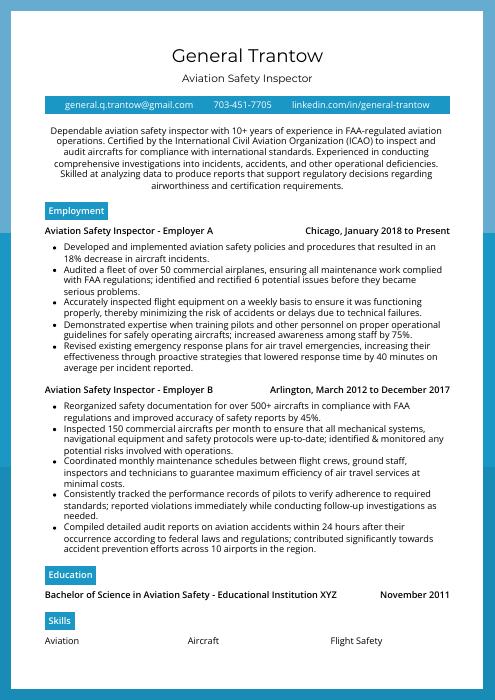 Rhea
Rhea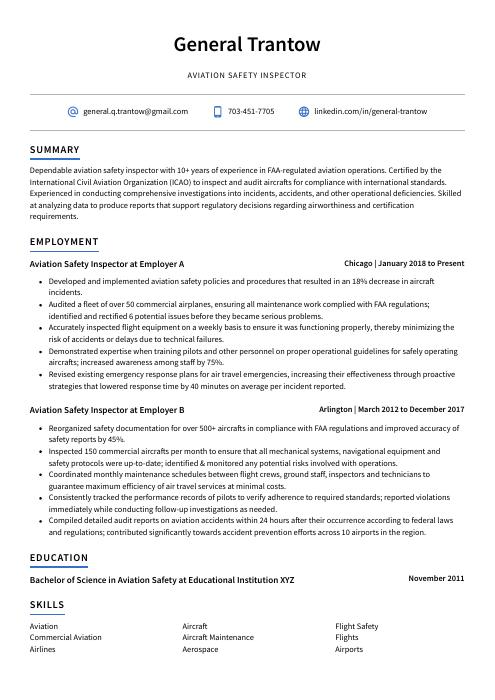 Axolotl
Axolotl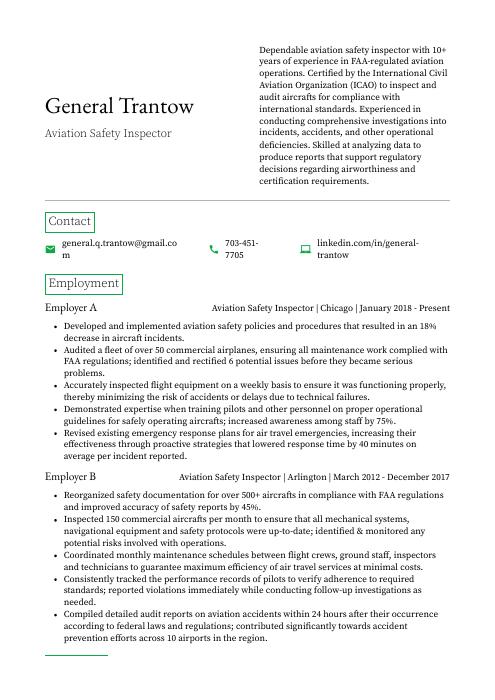 Quokka
Quokka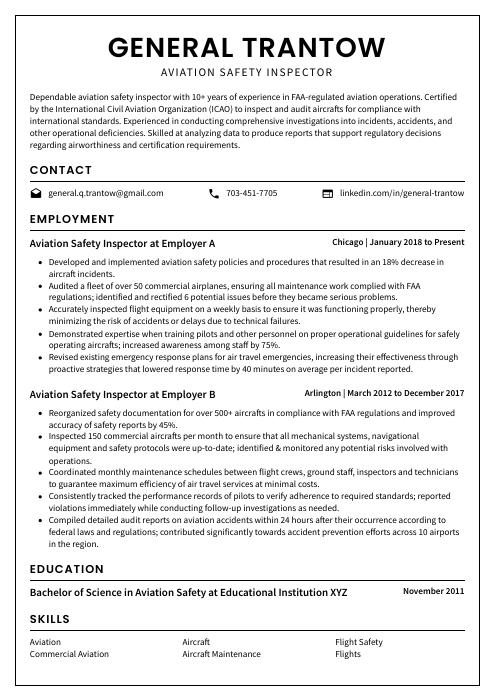 Cormorant
Cormorant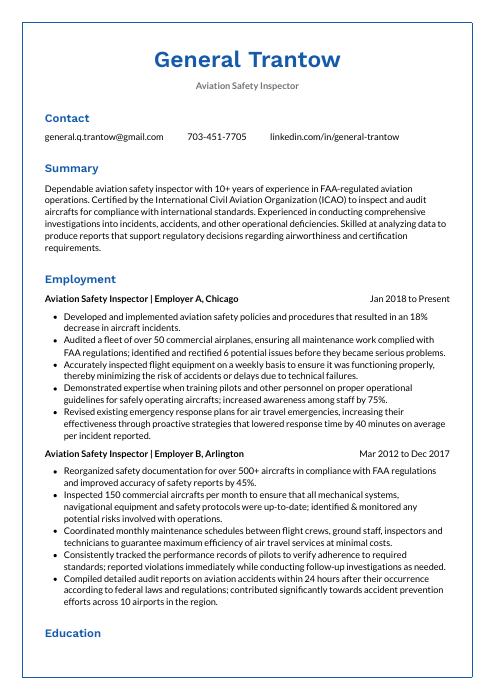 Markhor
Markhor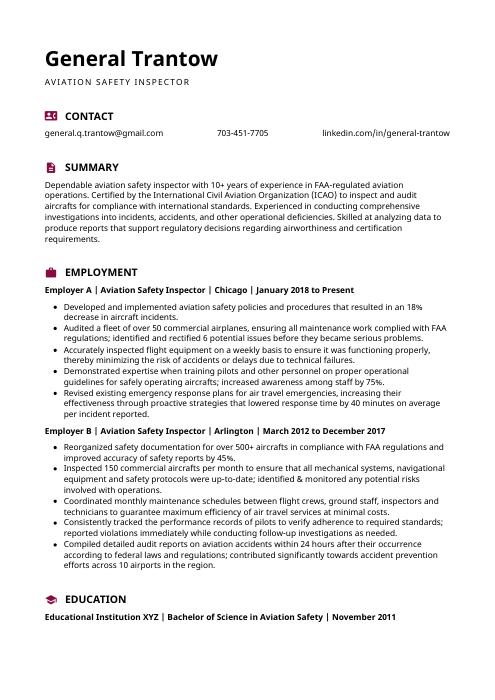 Hoopoe
Hoopoe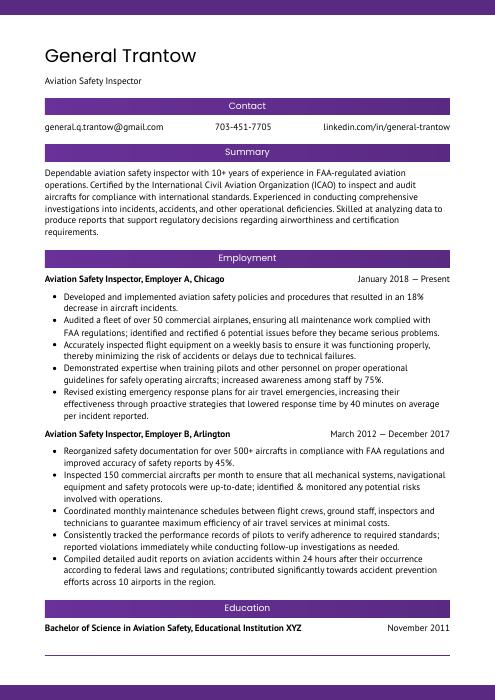 Jerboa
Jerboa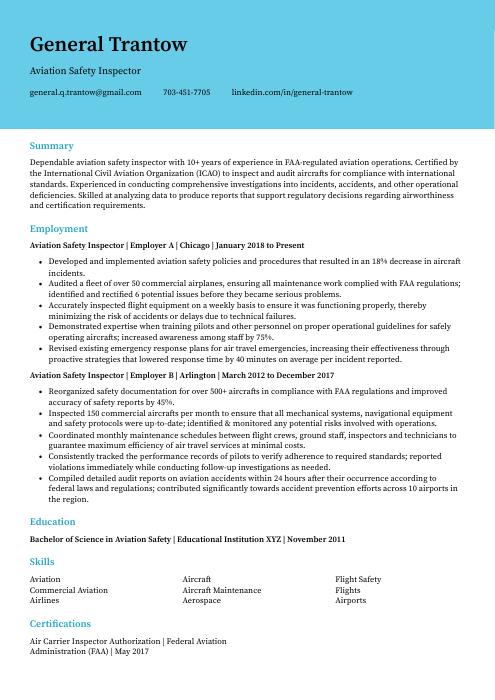 Dugong
Dugong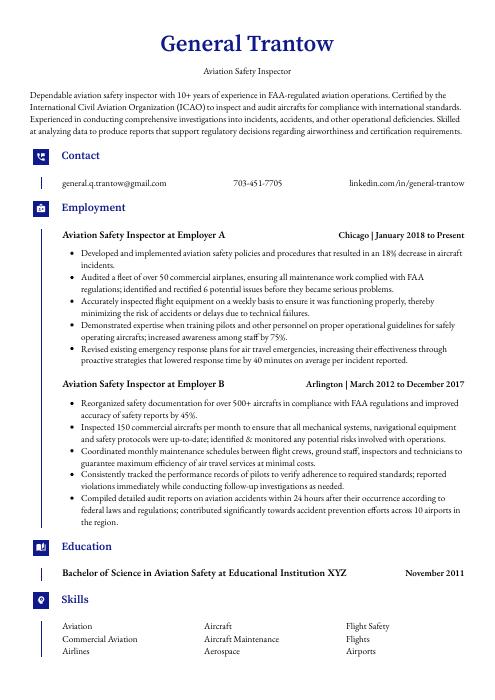 Gharial
Gharial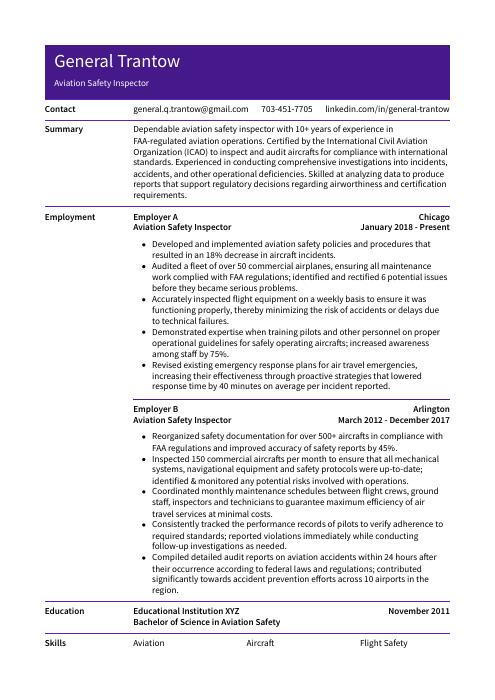 Pika
Pika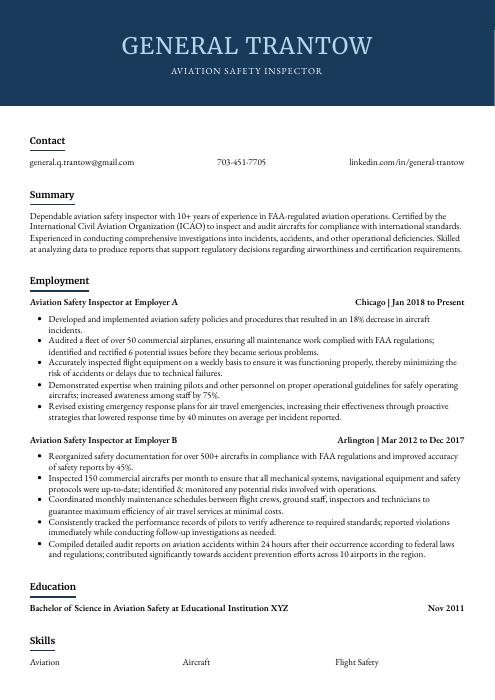 Bonobo
Bonobo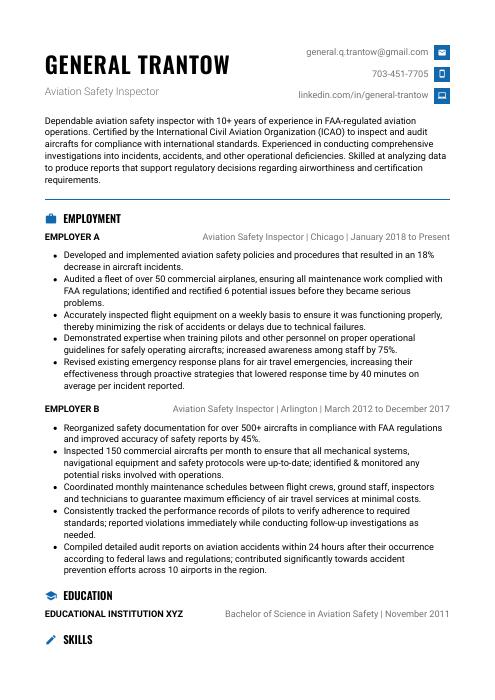 Echidna
Echidna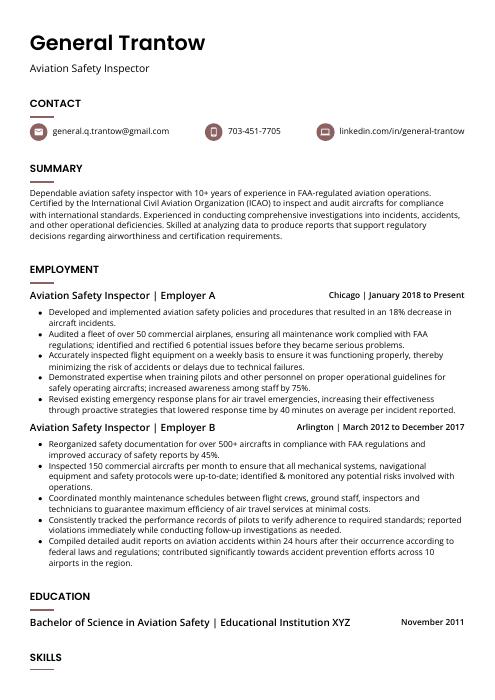 Fossa
Fossa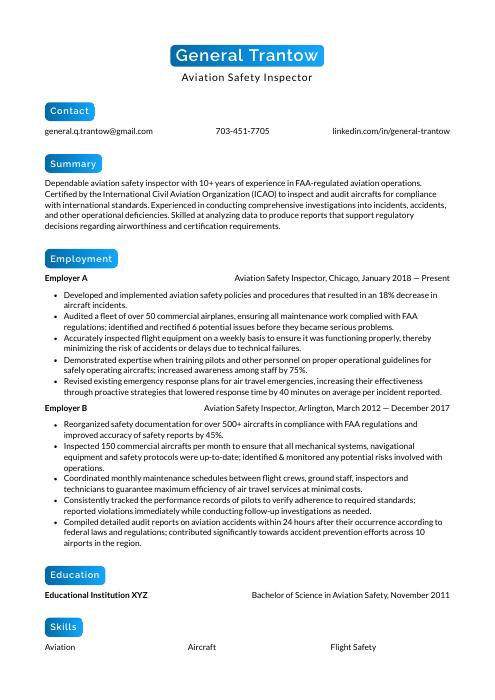 Kinkajou
Kinkajou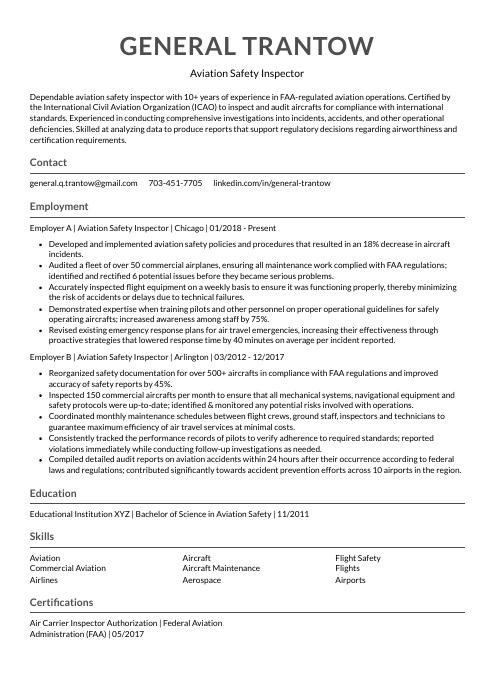 Indri
Indri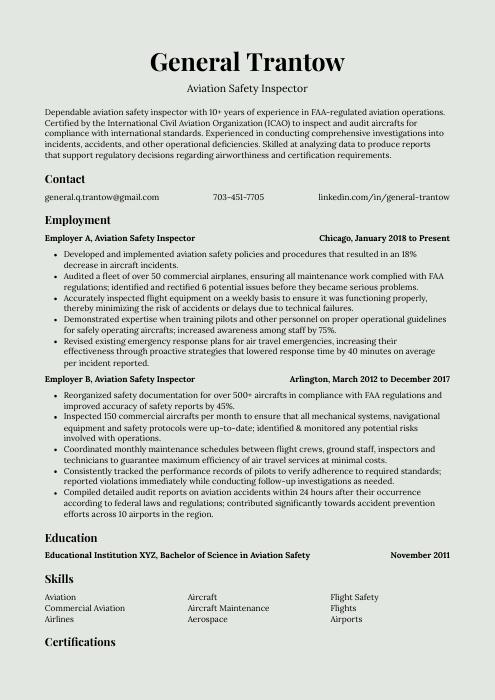 Saola
Saola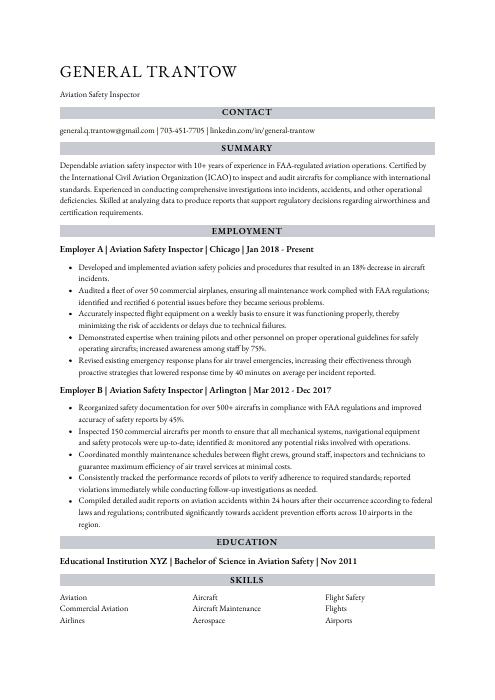 Numbat
Numbat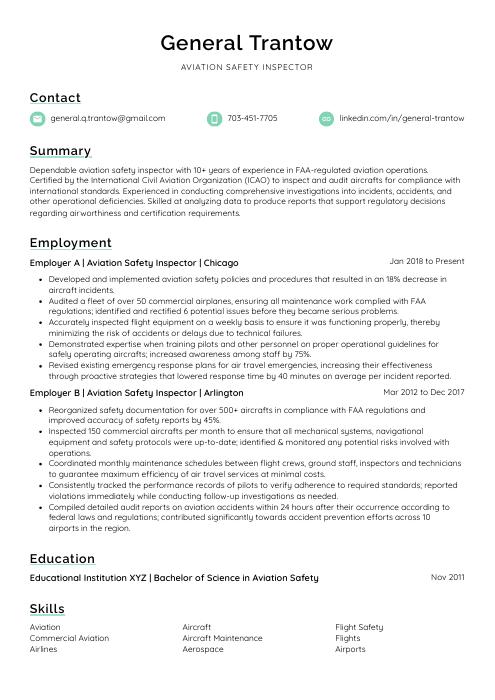 Lorikeet
Lorikeet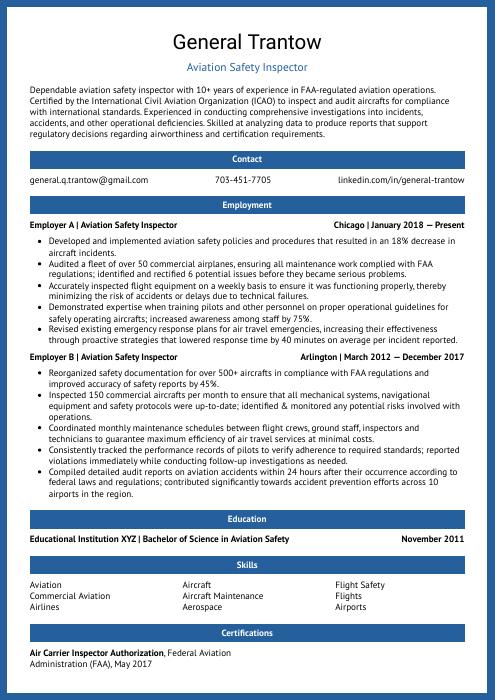 Ocelot
Ocelot Rezjumei
Rezjumei
